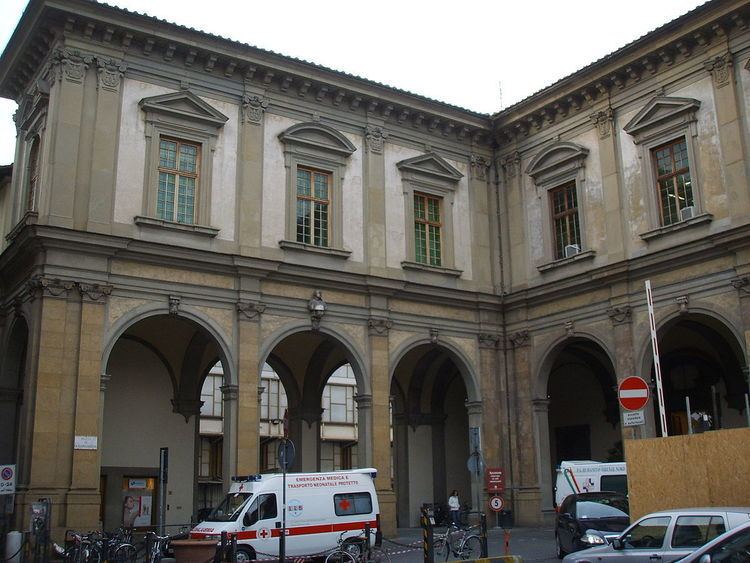Phone +39 055 69381 | ||
 | ||
Address Piazza Santa Maria Nuova, 1, 50122 Firenze, Italy Hours Open today · Open 24 hoursWednesdayOpen 24 hoursThursdayOpen 24 hoursFridayOpen 24 hoursSaturdayOpen 24 hoursSundayOpen 24 hoursMondayOpen 24 hoursTuesdayOpen 24 hours Similar Ospedale degli Innocenti, Santissima Annunziata - Florence, San Marco - Florence, Santa Trinita, Orsanmichele | ||
The Hospital of Santa Maria Nuova (i.e. Ospedale di Santa Maria Nuova in Italian) is the oldest hospital still active in Florence, Italy.
Contents
Origins
The hospital was founded in 1288 by Folco Portinari, the father of Beatrice beloved by Dante. Folco was convinced to build the hospital by Monna Tessa, matriarch of the family, whose remains are buried under the tombstone is still visible in the Cloister of the Bones of the Hospital.
This is one of the oldest and most important Florentine welfare institutions which became over the centuries very rich and powerful, thanks to the many legacies and donations. Besides the historical perspective, the hospital has a rich artistic legacy due to the profusion of decorations by some of the best Florentine artists over the centuries. Unfortunately, hospital needs have in many instances come into conflict with the need for conservation of artistic works. As such, there are many masterpieces in museums located nearby, such as Spedale degli Innocenti and San Marco Museum. The hospital was divided into two areas, female (woman's ward) and male (men's ward), and can accommodate about two hundred patients.
15th century
In the fifteenth century, the hospital enjoyed remarkable economic prosperity and in 1419 received a visit from Pope Martin V. In 1420 the addition of the cloister of the medical center by Bicci di Lorenzo marked a major transformation and expansion of the original building. The addition still has a terracotta lunette depicting the Pietà by Giovanni della Robbia and clay sculpture with the Madonna with Child and two angels, attributed to Michelozzo. In the early decades of the fifteenth century the aisles were decorated by Niccolò di Pietro Gerini with frescoes that are now partially preserved in the original locations and some were detached and placed in the living roomof Pope Martin V where they now have the office of the hospital president. In the Cloister of the Bones was a detached fresco representing Last Judgment by Fra Bartolomeo, now at San Marco Museum.
16th century
Further works were done in the late sixteenth century by important artists:
These works have been moved to the Pinacoteca of the Spedale degli Innocenti. Bernardo Buontalenti designed the large porch that is the main entrance to the hospital and regrettably did not live long enough to see its implementation. Construction of the porch was begun in 1611 by Giulio Parigi and finally brought to completion in 1960.
17th century
In 1660 the old lanes of the women's ward were replaced by Giovanni Battista Pieratti with a new more spacious environment.
Pope Martin V Administrative Hall
In the administrative hall (room and lounge of the hospital president), which are accessed by a staircase in the Cloister of Bones, there are frescos and other works from the facade of the Church of Sant'Egidio and from other monasteries. The works in this hall are/have been:
The Cloister of Bones
The Cloister of Bones, a temple and formerly a burial site, was built in the nineteenth century by Costoli in pietra serena. The temple has columns and pillars and on the center is the statue of the Marquis Angiolo Galli Tassi. The statue has the inscription in the back: "From the benefactor to the beneficiaries - Year 1863". On the front the statue has the following inscription: "Count Angiolo Galli - that emulating the love of the ancients - the ancestral heritage linked - to hospitals in Tuscany". There is also an inscription with the sculpture of Monna Tessa, the inspiration of the legendary Folco Portinari, from the church of Santa Margherita de' Cerchi.
